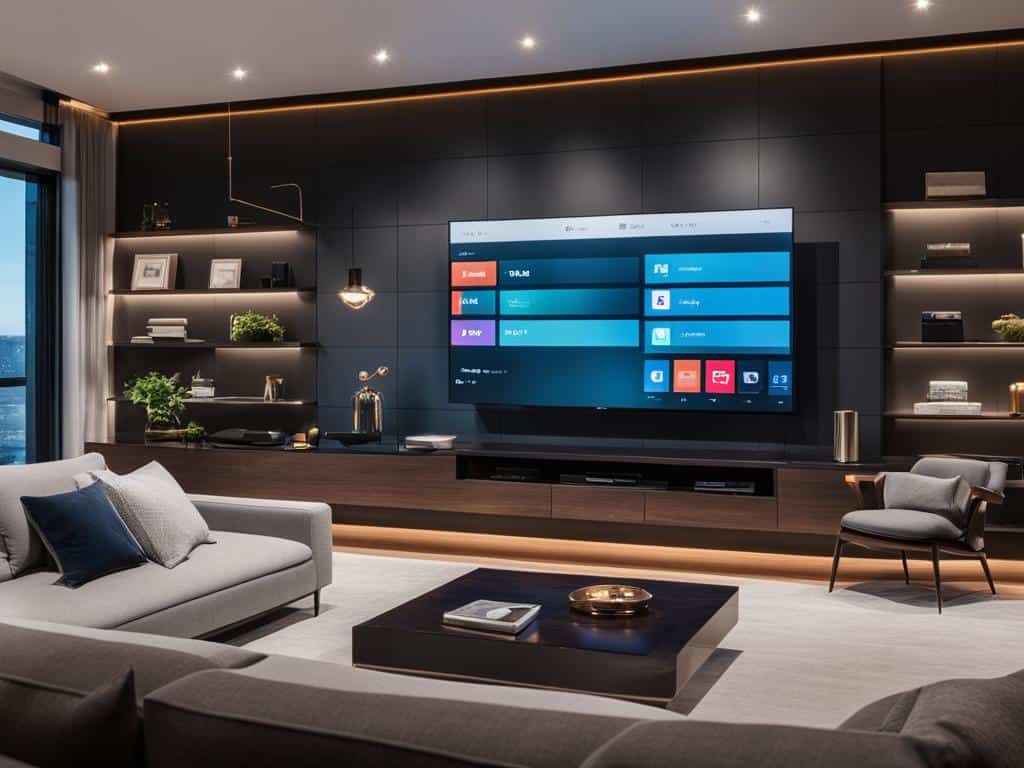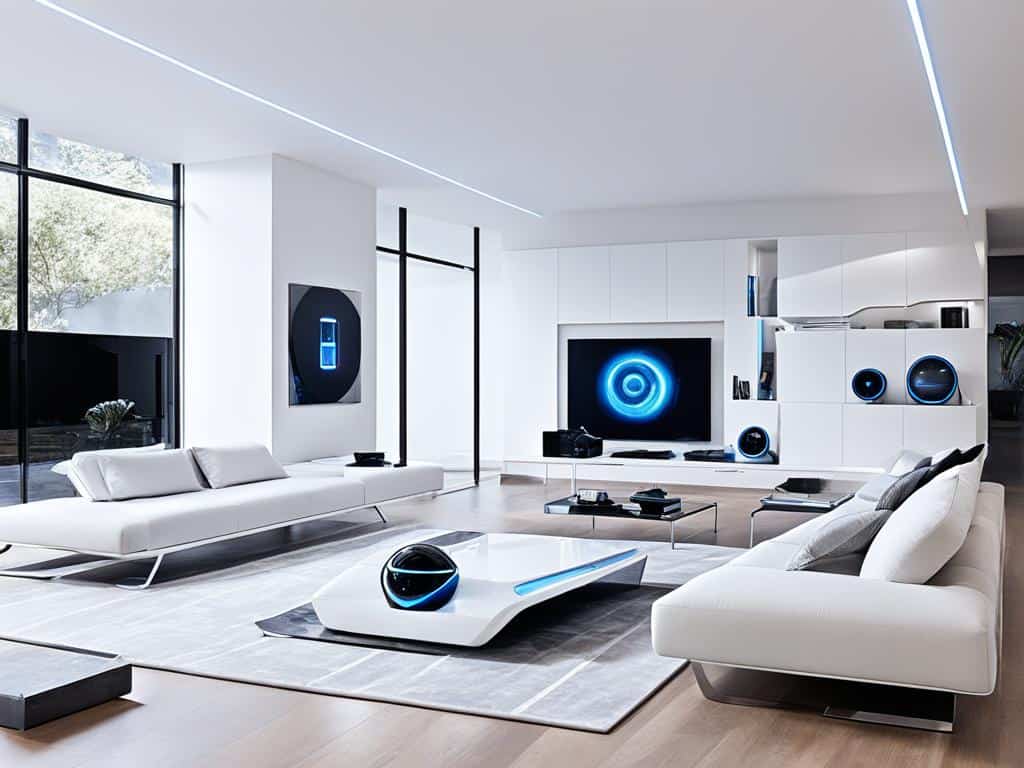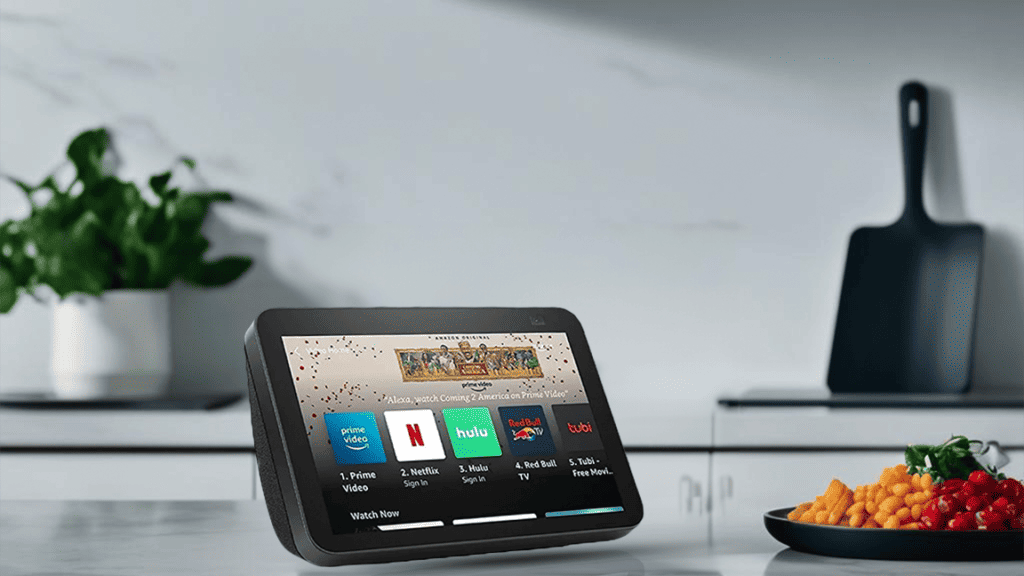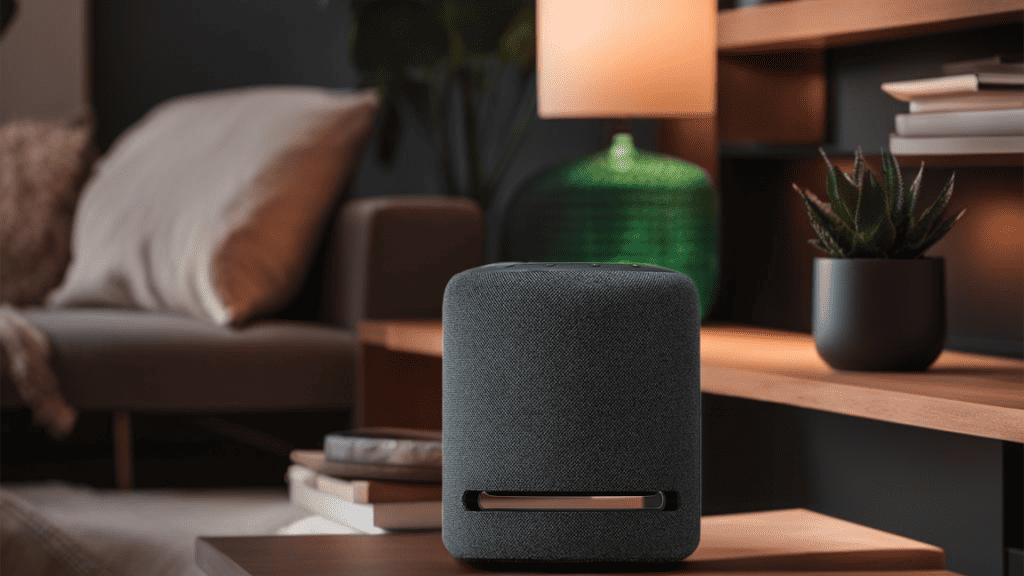Discover the wonders of smart home technology and unlock a new level of convenience, efficiency, and security for your living space. With home automation and connectivity at your fingertips, managing various aspects of your home has never been easier.
Imagine controlling your lights, appliances, and security systems with simple voice commands or a tap on your smartphone. Smart home technology seamlessly integrates into your daily routines, making your life more efficient and freeing up valuable time.
Key Takeaways:
- Smart home technology offers convenience, efficiency, and security for connected homes.
- Home automation allows you to control various aspects of your home using voice commands or smartphone apps.
- Smart home technology enhances energy efficiency and reduces utility bills.
- Integration possibilities include voice assistants, smart lighting systems, and smart locks.
- Choosing the right smart home devices requires research on reliability, compatibility, and customer support.
The Benefits of Smart Home Technology
Smart home technology offers numerous advantages to homeowners, providing a range of benefits from convenience and time-saving to energy efficiency and cost reduction. By integrating automation and connectivity into our daily lives, smart home technology improves the way we interact with our homes, making everyday tasks more efficient and enjoyable.
Convenience and Time-Saving
With smart home technology, you have control at your fingertips. Through voice commands or smartphone apps, you can easily manage various aspects of your home, including lighting, temperature, security, and even appliances. Imagine being able to adjust the thermostat, turn off lights, and lock doors with a simple voice command or a tap on your smartphone. Smart home technology eliminates the need to manually handle these tasks, saving you time and effort.
Energy Efficiency and Cost Reduction
Smart home technology is designed to optimize energy consumption and reduce utility bills. Automated thermostats help regulate temperature based on occupancy and usage patterns, ensuring optimal comfort while minimizing energy waste. Smart lighting systems allow you to schedule and control lights remotely, maximizing energy efficiency. Energy monitoring tools provide real-time insights into energy usage, empowering homeowners to make informed decisions that can lead to significant savings on utility bills.

GE Energy Management | Occupancy Sensing Wireless Thermostat
- Using a built-in occupancy sensor, differentiates between incidental and guest occupancy to completely eliminate unnecessary energy use
- Effortless installation
- Easy plug and play installation via quick connector

Smart Home Energy Monitor
- Monitor your home’s real power anywhere, anytime to prevent costly repairs, conserve energy, and save costs.
- Monitor solar / net metering.
- Accurately monitor your air conditioner, furnace, water heater, washer, dryer, range to save costs.
| Benefits of Smart Home Technology | Description |
|---|---|
| Convenience and Time-Saving | Control various aspects of your home with ease, saving time and effort. |
| Energy Efficiency and Cost Reduction | Optimize energy consumption, reduce utility bills, and save money. |
Reducing Your Carbon Footprint
By promoting energy efficiency and reducing wasteful practices, smart home technology also contributes to a greener lifestyle. By managing and minimizing energy consumption, you can significantly reduce your carbon footprint, helping to combat climate change and create a more sustainable future for generations to come.
Smart home technology allows seamless control and automation of various home devices, leading to increased convenience, energy efficiency, and reduced costs.
Investing in smart home technology not only enhances your living environment but also aligns with your commitment to sustainability. By embracing the power and potential of connected homes, you can take active steps to reduce energy consumption, save money, and make a positive impact on the environment while enjoying the utmost convenience in your daily life.
Key Features and Integration Possibilities
Modern smart home technology offers a wide range of features and integration possibilities to enhance your daily tasks. Let’s explore some of the key components that make up a smart home ecosystem:
Voice Assistants
Voice assistants, such as Amazon Alexa and Google Assistant, serve as the central command center for your smart home. These intelligent devices allow you to control multiple smart devices using simple voice commands. With just a few words, you can dim the lights, adjust the thermostat, or even ask for a weather update.
Smart Lighting Systems
Smart lighting systems are a game-changer when it comes to creating the perfect ambiance in your home. These systems allow you to adjust the brightness, color, and even set schedules for your lights. Whether you want a cozy movie night or a vibrant party atmosphere, smart lighting systems can instantly transform your space.
Smart Locks
Enhance the security of your home with smart locks. These advanced locks offer keyless entry, allowing you to unlock your doors using your smartphone or a secret code. You can also monitor your locks remotely, ensuring that your home is secure even when you’re away.

Level Lock+ Connect Wi-Fi Smart Lock Plus Apple Home Keys | Remotely Control locks from Anywhere
- Security meets style with this small, discreet smart lock available in various sophisticated finishes
- Seamlessly integrate Lock+ with your existing door hardware, with no visible technology on the inside or outside
- Forget your keys at home – on purpose. Access your home effortlessly by tapping Lock+ with your iPhone or Apple Watch, using the key stored in your Apple Wallet, just as you would when making a purchase
Interconnected Ecosystem
A truly smart home is one where all the devices work together seamlessly. By syncing your smart home devices with other appliances, you can create an interconnected ecosystem that simplifies your daily tasks. For example, you can set your smart lights to turn on as soon as your smart lock detects your arrival, creating a warm welcome every time you come home.
Designing a table with the top smart home brands and their respective features can assist homeowners in making well-informed decisions.
With these innovative features and integration possibilities, smart home technology has revolutionized the way we interact with our homes, making daily tasks more convenient and enjoyable.
Choosing the Right Smart Home Technology
When it comes to incorporating smart home technology into your living space, selecting the right devices and systems is essential. Finding smart home devices that align with your specific needs and preferences will ensure a seamless integration into your daily routines.
One crucial factor to consider is reliability. Researching various brands and reading customer reviews will provide insights into the performance and durability of different smart home devices. Look for devices that have a track record of consistent performance and positive user experiences.
Another crucial aspect to evaluate is compatibility. Determine whether the smart home devices you’re considering are compatible with your existing devices and systems. Checking compatibility beforehand can save you from headaches and ensure that all your devices work harmoniously within your smart home ecosystem.
Furthermore, ease of use plays a significant role in the overall user experience. Look for devices that offer user-friendly interfaces, intuitive controls, and easy setup processes. A seamless user experience will enhance your enjoyment and make it effortless to integrate smart home technology into your daily life.
Consider the installation requirements of smart home devices. Some devices may require professional installation, while others can be easily installed by homeowners themselves. Understand the installation process before making any purchases to ensure that you can set up the devices with ease.
In addition to the features and installation, it’s important to assess the customer support offered by the brands you’re considering. Look for companies that provide responsive customer support, whether it be through phone, email, or online chat. Reliable customer support will offer assistance and troubleshooting when you encounter any issues with your smart home devices.
To summarize, choosing the right smart home technology involves considering factors such as reliability, compatibility, ease of use, installation requirements, and customer support. By conducting thorough research and assessing these key aspects, you can make informed decisions that align with your priorities and enhance your smart home experience.
| Factors to Consider | Description |
|---|---|
| Reliability | Research brands and read reviews to ensure consistent performance. |
| Compatibility | Check if devices are compatible with existing devices and systems. |
| Ease of Use | Look for devices with user-friendly interfaces and intuitive controls. |
| Installation Requirements | Understand if devices require professional installation or can be DIY. |
| Customer Support | Assess the availability and responsiveness of customer support. |
What is a Smart Home?
A smart home is a residence that leverages the power of internet-connected devices to enable remote monitoring and management of appliances and systems. Also known as home automation or domotics, smart home technology offers homeowners a range of benefits, including enhanced security, comfort, convenience, and energy efficiency. By seamlessly integrating various IoT devices, smart home systems create an interconnected ecosystem that operates based on homeowners’ preferences and automates actions accordingly.
Smart home technology provides homeowners with the ability to remotely monitor and control their homes, even when they are away. Whether it’s adjusting the thermostat, turning off the lights, or monitoring security cameras, the convenience is unparalleled. With the rise of voice assistants, such as Amazon Alexa and Google Assistant, controlling your smart home is as simple as uttering a command.
An integral part of smart home technology is home automation. Through this automation, different smart devices communicate with each other, sharing usage data and working in harmony to optimize various daily tasks. For example, when you arrive home, your smart lights can automatically turn on, and your smart thermostat can adjust the temperature to your preferred level. These actions are based on predefined routines or can be controlled through voice commands.
Benefits of Smart Home Technology:
- Enhanced security: With remote monitoring capabilities, homeowners can keep an eye on their homes and receive instant notifications in case of any suspicious activity.

Google Nest Hub Max 10" Smart Display with Google Assistant
Leave video messages for each other on Nest Hub Max, Make video calls or leave video messages with Duo hands-free,10-inch HD touchscreen, 30W subwoofer for high-quality audio, and Google Assistant makes issuing commands simple.

MyQ Smart Garage Door Video Keypad
Wide-Angle Camera, Customizable PIN Codes, and Smartphone Control – Take Charge of Your Garage Access – Works with Chamberlain, LiftMaster and Craftsman openers

Eufy Security C210 WiFi Smart Lock
Keyless Entry, Touchscreen Keypad, App Control, No Bridge, Easy Installation, BHMA Certified
- Comfort and convenience: Smart home technology streamlines daily tasks by automating processes such as turning on/off lights, adjusting room temperature, or even starting the coffee maker.
- Energy efficiency: Through smart thermostats, lighting systems, and energy monitoring tools, homeowners can optimize energy consumption, resulting in reduced utility bills and a smaller carbon footprint.

Alarm.com Smart Thermostat | HD
- Sleek, color touchscreen display for an engaging customer experience that delivers the next-level of comfort and control
- Easy setup wizard, and local configuration, the Smart Thermostat HD makes installation a breeze
- Can also monitor the health of the heating and cooling system, deliver monthly performance reports, and even alert you to potential HVAC issues right on its display
Additionally, smart home technology offers peace of mind by providing remote access to security cameras, door locks, and sensors. This allows homeowners to ensure the safety of their homes and loved ones, no matter where they are.
To give you a clearer picture, here is a table highlighting the key features and devices commonly found in a smart home:
| Smart Home Devices | Features |
|---|---|
| Smart Lighting Systems | Adjust brightness, color, and set schedules |
| Smart Thermostats | Control temperature remotely and optimize energy usage |
| Smart Locks | Enhanced security with keyless entry |
| Smart Security Cameras | Monitor and record real-time footage |
| Smart Kitchen Appliances | Automation and convenience in the kitchen |
As technology continues to advance, smart homes are becoming more accessible and affordable. The integration of internet-connected devices offers a new level of control, comfort, and convenience for homeowners. With the ability to remotely monitor and manage various systems and appliances, smart home technology has rapidly gained popularity and is transforming the way we live.
In the next section, we will delve into how smart home technology works and the key components that make it all possible.
How Does Smart Home Technology Work?
A smart home is more than just a collection of individual smart devices. It operates as a network of devices that work together seamlessly to enhance your living experience. At the heart of this network is a central automation controller, known as a smart home hub, which serves as the control center for all your smart devices.
The smart home hub communicates wirelessly with various devices, such as lights, thermostats, security systems, and more. This wireless communication allows for easy and convenient control of your smart home from anywhere within your home, or even remotely when you’re away.
One of the key features of smart home technology is the ability to program or set your devices to respond to voice commands. By utilizing home assistants like Amazon Alexa or Google Assistant, you can control multiple devices with a simple voice command. Whether it’s turning on the lights, adjusting the thermostat, or locking the doors, voice commands provide an effortless way to interact with your smart home.
Through the integration of smart devices and the use of wireless communication and voice commands, a smart home creates a network that can be remotely controlled and monitored. This intelligent network enhances convenience, efficiency, and security, allowing you to effortlessly manage various aspects of your home with ease.
To further illustrate how smart home technology works, take a look at the table below:
| Smart Device | Functionality |
|---|---|
| Smart Lighting Systems | Adjust brightness, color, and set schedules |
| Smart Thermostats | Control temperature settings and save energy |
| Smart Security Systems | Monitor and secure your home remotely |
| Smart Home Assistants | Respond to voice commands and control multiple devices |
As you can see, smart home technology brings together a range of devices and functionality to create a connected and intelligent home environment. By harnessing the power of wireless communication and voice commands, you can transform your home into a smart home that is easy to control, energy-efficient, and enhances your overall quality of living.
Examples of Smart Home Technologies
The evolution of smart home technology has brought convenience and automation to almost every aspect of our lives. Let’s explore some of the innovative devices that have revolutionized the way we interact with our homes:
1. Smart TVs
Smart TVs have become a staple in modern households. These internet-connected devices offer access to a wide range of content through applications, allowing you to stream movies, TV shows, and even play games with ease. Control your entertainment experience and enjoy your favorite shows with the power of smart technology.
2. Smart Lighting Systems
With smart lighting systems, you can create the perfect ambiance for any occasion. These systems provide control over brightness, color, and even allow for automated adjustments based on occupancy. Whether you want to set a relaxing atmosphere or brighten up your space for a party, smart lighting systems offer versatility and convenience.

Philips Hue Smart Light Starter Kit | Control with App or Voice Assistant
- Includes one Hue bridge, one smart button, and three White Ambiance smart 75W-equivalent A19 warm-to-cool white light bulbs; Perfect for general lighting anywhere in your home
- Choose from shades of warm-to-cool white light to enhance your room décor and ambiance; cool white light to focus or energize, warm white light to relax.
- Convenient smart control; Set up voice control in the Hue app and use simple voice commands to control your lights with Alexa or Google Assistant
3. Smart Thermostats
Smart thermostats bring energy efficiency and comfort to your home. By allowing remote temperature control and energy monitoring, these devices help optimize energy consumption, reducing both your carbon footprint and utility bills. Stay cozy during winter and cool during summer while saving resources and money.
4. Smart Locks
Enhance the security of your home with smart locks. These advanced devices provide keyless entry and allow for remote monitoring and control. Grant access to family members, friends, or service providers remotely, and receive notifications when someone enters or exits your home. Smart locks offer peace of mind and convenience.

Level Lock+ Connect Wi-Fi Smart Lock Plus Apple Home Keys | Remotely Control locks from Anywhere
- Security meets style with this small, discreet smart lock available in various sophisticated finishes
- Seamlessly integrate Lock+ with your existing door hardware, with no visible technology on the inside or outside
- Forget your keys at home – on purpose. Access your home effortlessly by tapping Lock+ with your iPhone or Apple Watch, using the key stored in your Apple Wallet, just as you would when making a purchase
5. Smart Security Cameras
Keep an eye on your home no matter where you are with smart security cameras. These devices enable remote monitoring, allowing you to view live or recorded footage of your property. Some models come equipped with advanced features like motion detection and night vision, ensuring the safety and security of your home.
6. Smart Kitchen Appliances
Transform your kitchen into a smart cooking space with innovative kitchen appliances. From smart refrigerators that can alert you when you’re running low on groceries to intelligent ovens that can be controlled remotely, these devices offer convenience and automation. Prepare delicious meals with ease and manage your kitchen efficiently.

Tovala Smart Oven Pro, 6-in-1 Countertop Convection Oven | Steam, Toast, Air Fry, Bake, Broil, and Reheat
7. Smart Plugs
Turn any ordinary home device into a smart device with smart plugs. These simple yet powerful devices enable you to control and automate the operation of various electronics and appliances remotely. Set schedules, monitor energy usage, and enjoy the convenience of controlling your devices from anywhere.

Kasa Smart Plug Smart Home Wi-Fi Outlet | Works with Alexa, Google Home
- Kasa smart plugs that work with Alexa and Google Home Assistant. Enjoy the hands free convenience of controlling any home electronic appliances with your voice via Amazon Alexa or Google Assistant
- Easy set up and use: 2.4GHz Wi-Fi connection required. Plug in, open the case app, follow the simple instructions and enjoy
- Use timer or countdown schedules set your smart plug to automatically turn on and off any home electronic appliances such as lamps, fan, humidifier, Christmas lights etc
- Turn electronics on and off from anywhere with your smartphone using the Kasa app, whether you are at home, in the office or on vacation
| Smart Home Technology | Main Features |
|---|---|
| Smart TVs | Internet-connected devices for accessing content through applications |
| Smart Lighting Systems | Control over brightness and automated adjustments based on occupancy |
| Smart Thermostats | Remote temperature control and energy monitoring |
| Smart Locks | Enhanced security and keyless entry |
| Smart Security Cameras | Remote monitoring and advanced features like motion detection |
| Smart Kitchen Appliances | Convenience and automation for cooking tasks |
| Smart Plugs | Transform ordinary devices into remotely controlled ones |
Smart Home Pros and Cons
Smart home technology offers numerous advantages for homeowners. Let’s explore some of the key benefits:
1. Remote Monitoring
With smart home technology, you can monitor your home remotely, giving you peace of mind when you’re away. You can check security cameras, lock doors, and control appliances, all from your smartphone or tablet.
2. Convenience
Smart homes make life more convenient by automating various tasks. You can set schedules for your lights, thermostat, and other devices, ensuring your home is comfortable and energy-efficient when you arrive.
3. Energy Efficiency
Smart home technology helps reduce energy consumption and lower utility bills. You can optimize your heating and cooling system with smart thermostats, control lighting to reduce wastage, and monitor energy usage to make informed decisions.
4. Security Concerns
Despite the benefits, there are some security concerns associated with smart home technology. Connecting devices to the internet increases the risk of unauthorized access. It’s essential to implement robust security measures and regularly update firmware to mitigate these risks.
5. Lack of Standards
Smart home technology lacks uniform standards, leading to compatibility issues between different brands and products. It’s important to do thorough research and ensure that the devices you choose are compatible with each other and adhere to established protocols.
In conclusion, smart home technology offers remote monitoring, convenience, energy efficiency, and a host of other benefits. However, it’s crucial to address the security concerns and lack of standards through proper precautions and informed decision-making.
How to Set Up a Smart Home
Setting up a smart home is easier than you might think. Whether you’re moving into a newly built home or retrofitting your existing residence, incorporating smart home technology can enhance your living experience. Let’s explore the steps involved in setting up your own smart home.
Smart Home Infrastructure
First, assess the smart home infrastructure available in your home. New constructions often come equipped with smart home infrastructure, such as pre-installed wiring and seamless integration capabilities. This infrastructure lays the foundation for easy implementation of smart devices and systems.
Compatibility with Communication Protocols
One crucial consideration in setting up a smart home is the compatibility of your devices with communication protocols. The two most common protocols are Zigbee and Z-Wave. These protocols facilitate wireless communication between different devices in your smart home ecosystem.
| Zigbee | Z-Wave |
|---|---|
| Operates on the 2.4 GHz frequency | Operates on the 908.42 MHz frequency |
| Supports a larger number of devices | Offers greater range and device compatibility |
| Creates a mesh network for device communication | Utilizes a single-hop network structure |
The Matter Protocol
Introduced in 2022, the Matter protocol is gaining momentum in the smart home industry. It aims to establish a unified standard that solves compatibility challenges across different brands and devices. By adopting the Matter protocol, smart home systems will be able to effortlessly integrate and communicate with each other, ensuring a seamless experience for homeowners.
Smart Home Kits
Setting up a smart home can be simplified by using smart home kits. These kits usually include a range of devices, such as smart assistants, smart thermostats, smart lighting systems, and more. They are designed to work together seamlessly, minimizing compatibility issues and streamlining the installation process.
Consider your specific needs and preferences when choosing a smart home kit. Different kits offer varying functionalities and levels of automation, allowing you to tailor your smart home experience to suit your lifestyle.
With the right infrastructure, compatible communication protocols, and smart home kits, you can create a sophisticated and interconnected smart home ecosystem. Enjoy the convenience and efficiency that smart home technology brings to your daily life.

Ecobee | Smart Home Kit
- Built-in air quality monitor alerts you to poor air quality, provides tips on how to improve it, and reminds you when it’s time to change your furnace’s air filter.
- Secure your home’s doors and windows with contact sensors that monitor entry, exit, and motion
- Get smart, customizable alerts when entry, exit, or motion is detected inside your home (requires an Ecobee Smart Security subscription)
Five Advancements in Smart Home Technology for Efficiency and Convenience
Smart home technology continues to evolve, offering homeowners increased efficiency and convenience. With advancements in various areas, such as smart thermostats, smart lighting, smart shades, smart irrigation, and smart energy meters, homeowners can optimize their living spaces for maximum comfort and energy savings.
1. Smart Thermostats
Smart thermostats take temperature control to the next level by optimizing it based on daily habits. Equipped with sensors and learning capabilities, these devices adjust settings to ensure optimal comfort while minimizing energy waste. By adapting to your preferred temperature patterns, smart thermostats not only enhance convenience but also contribute to energy efficiency.
2. Smart Lighting Systems
Smart lighting systems offer a customizable and energy-efficient way to light up your home. With the ability to adjust brightness, color, and even create schedules, you can easily set the perfect ambiance in any room. By reducing energy waste through automated controls and efficient LED bulbs, smart lighting systems help lower utility costs and promote sustainability.

Philips Hue Smart Light Starter Kit | Control with App or Voice Assistant
- Includes one Hue bridge, one smart button, and three White Ambiance smart 75W-equivalent A19 warm-to-cool white light bulbs; Perfect for general lighting anywhere in your home
- Choose from shades of warm-to-cool white light to enhance your room décor and ambiance; cool white light to focus or energize, warm white light to relax.
- Convenient smart control; Set up voice control in the Hue app and use simple voice commands to control your lights with Alexa or Google Assistant
3. Smart Shades
Smart shades provide an innovative solution for managing light and heat gain in your home. These intelligent window coverings can automatically adjust throughout the day to optimize natural light and maintain comfortable indoor temperatures. By reducing the need for excessive air conditioning or heating, smart shades contribute to energy savings and create a more pleasant living environment.

Smart Shade | Solar Powered compatible with Alexa
- Customizable smart motorized roller shade
- Operate with you phone or remote control
- Compatible with Alexa & Echo | No bridge necessary
- Solar Powered
4. Smart Irrigation Systems
Smart irrigation systems revolutionize the way we water our gardens and lawns. By incorporating real-time weather data, soil moisture sensors, and adjustable schedules, these systems ensure efficient water usage. Smart irrigation allows you to maintain healthy plants while conserving water resources, resulting in greener landscapes and lower water bills.
5. Smart Energy Meters
Smart energy meters provide real-time insights into your energy usage, allowing you to make informed decisions about your consumption patterns. By monitoring electricity usage and identifying energy-hungry appliances, smart energy meters empower homeowners to adopt more sustainable habits. With this valuable information at your fingertips, you can take steps to reduce energy waste and lower your carbon footprint.
These advancements in smart home technology offer homeowners a range of benefits, from improved comfort and convenience to significant energy savings. By embracing these innovations, you can create a more efficient and eco-friendly living environment that enhances your daily life.

Smart Home Energy Monitor
- Monitor your home’s real power anywhere, anytime to prevent costly repairs, conserve energy, and save costs.
- Monitor solar / net metering.
- Accurately monitor your air conditioner, furnace, water heater, washer, dryer, range to save costs.
Investing in Smart Home Technology for Sustainability
Investing in smart home technology goes beyond mere convenience; it is also a step towards creating a sustainable living environment. With the advancement of smart home technology, homeowners can significantly reduce their energy consumption, resulting in both cost savings and enhanced comfort. By embracing smart home technology, you are actively contributing to sustainability efforts while enjoying the benefits it offers.
Reduced Energy Consumption: Smart home technology is designed to optimize energy usage by automating various aspects of your home. This includes smart thermostats that adjust temperature settings based on occupancy and time of day, smart lighting systems that automatically turn off lights when rooms are vacant, and energy monitoring tools that provide real-time insights into your energy usage. By reducing unnecessary energy consumption, you not only save on utility bills but also contribute to a greener future.
Cost Savings: One of the key advantages of smart home technology is its potential for long-term cost savings. By regulating energy usage and reducing wastage, homeowners can experience a substantial decrease in their utility bills. Additionally, the ability to remotely control and monitor household devices allows for efficient use of resources, further reducing expenses. Beyond energy savings, smart home technology can also minimize maintenance costs by proactively identifying and addressing issues before they become costly problems.
Enhanced Comfort: Smart home technology enhances the overall comfort level of your living space. With smart thermostats, you can easily adjust the temperature to your liking and have it automatically adapt to your preferred settings. Smart lighting systems provide customizable lighting options, allowing you to create the perfect ambiance for any occasion. By integrating various smart devices, you can streamline daily tasks and make your home an even more comfortable and enjoyable place to live.
Case Study: Energy Consumption Comparison
Let’s take a look at a comparison between a traditional home and a smart home in terms of energy consumption:
| Key Metrics | Traditional Home | Smart Home |
|---|---|---|
| Total Energy Consumption | 2,500 kWh/year | 1,800 kWh/year |
| Annual Energy Cost | $300 | $200 |
| Carbon Footprint | 2.5 tons/year | 1.8 tons/year |
This comparison demonstrates the significant reduction in energy consumption and cost savings that can be achieved through smart home technology. By investing in a smart home, homeowners not only enjoy the convenience and comfort it offers but also play an active role in promoting sustainable living.
Investing in smart home technology is a worthwhile endeavor for both homeowners and real estate professionals alike. Not only does it provide the convenience of controlling your home with ease, but it also contributes to sustainable living by reducing energy consumption, resulting in cost savings. Embrace the future of sustainable living by incorporating smart home technology into your lifestyle.
Conclusion
Integrating smart home technology into our modern lifestyle offers unparalleled convenience, energy efficiency, and sustainability. With the right selection of devices and systems, homeowners can transform their homes into smart havens that simplify and enhance everyday life.
Smart home technology brings a multitude of benefits to homeowners, including the convenience of controlling various aspects of the home through voice commands or smartphone apps. By automating tasks and optimizing energy consumption, smart homes promote energy efficiency and reduce utility bills – a win-win for both homeowners and the environment.
Moreover, investing in smart home technology contributes to a sustainable future. By reducing energy consumption and promoting greener practices, smart homes play a vital role in protecting our planet. The initial investment in smart home technology is not only financially advantageous but also creates a positive impact on both the environment and the overall quality of life.
FAQ
What is smart home technology?
Smart home technology refers to internet-connected devices that enable the remote monitoring and management of appliances and systems in a residence. It provides homeowners with security, comfort, convenience, and energy efficiency.
What are the benefits of smart home technology?
Smart home technology offers convenience and time-saving by allowing you to control various aspects of your home through voice commands or smartphone apps. It improves energy efficiency, optimizing energy consumption and reducing utility bills. It also helps reduce your carbon footprint.
What are some key features and integration possibilities of smart home technology?
Smart home technology offers integration possibilities such as voice assistants, smart lighting systems, and smart locks. You can create an interconnected ecosystem by syncing your smart home devices with other appliances, simplifying daily tasks.
How do I choose the right smart home technology?
When choosing smart home devices, research various brands and read reviews to ensure reliability and compatibility with other devices. Consider factors such as ease of use, installation requirements, and customer support.
What is a smart home?
A smart home is a residence that uses internet-connected devices to enable the remote monitoring and management of appliances and systems. Smart home technology provides homeowners with security, comfort, convenience, and energy efficiency.
How does smart home technology work?
Smart home technology utilizes a central automation controller, called a smart home hub, to communicate wirelessly with devices such as lights, thermostats, and security systems. Smart devices can be programmed or set to respond to voice commands through home assistants.
What are some examples of smart home technologies?
Examples of smart home technologies include smart TVs, smart lighting systems, smart thermostats, smart locks, smart security cameras, smart kitchen appliances, and smart plugs.
What are the pros and cons of smart home technology?
The pros of smart home technology include remote monitoring, convenience, energy efficiency, and enhanced security. However, there are also concerns related to security, lack of standards, and privacy.
How do I set up a smart home?
Smart home systems can be set up in newly built homes or retrofitted in older homes. Common communication protocols used in home automation include Zigbee and Z-Wave. The Matter protocol, launched in 2022, aims to solve compatibility challenges. Smart home systems can be set up from scratch using prototyping boards or purchased as bundled kits.
What are some advancements in smart home technology for efficiency and convenience?
Advancements in smart home technology include smart thermostats, smart lighting, smart shades, smart irrigation, and smart energy meters. These technologies optimize energy consumption and offer customization and automation.
Why should I invest in smart home technology for sustainability?
Investing in smart home technology not only enhances convenience but also creates a sustainable living environment. Smart home technology reduces energy consumption, resulting in cost savings and enhanced comfort. It’s a meaningful step towards sustainability.









